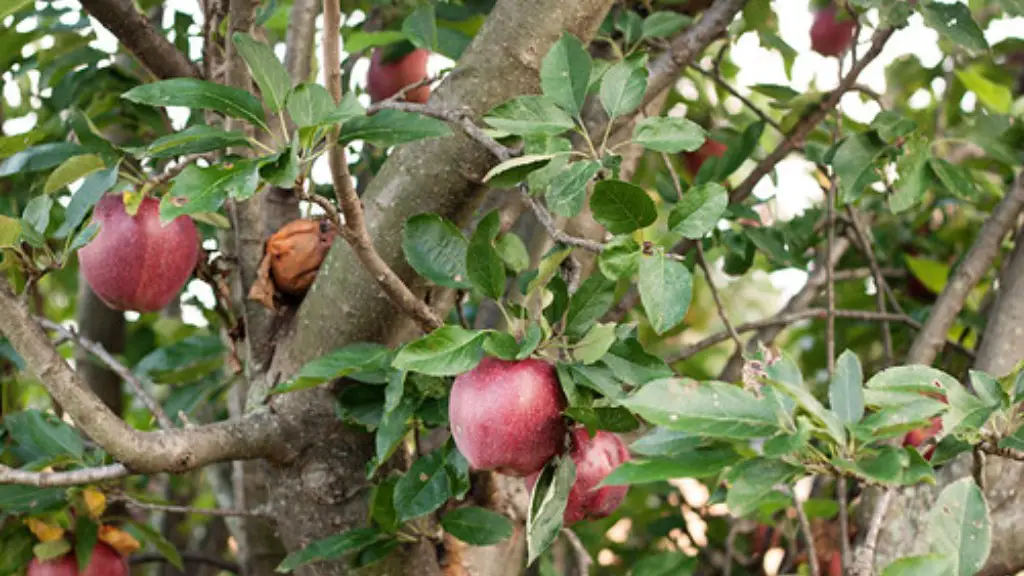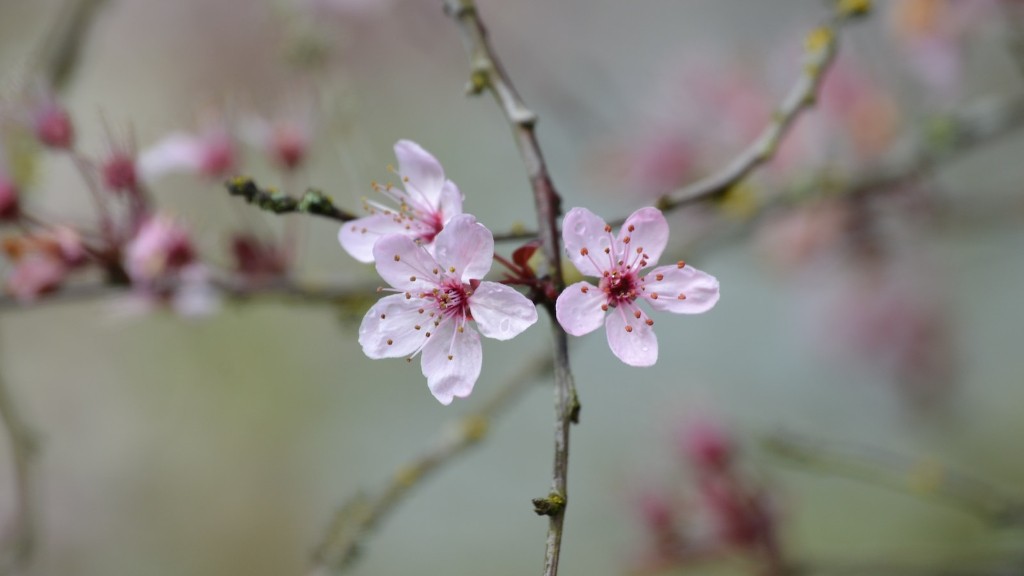Apples are a popular fruit and a delicious treat. Protecting them on the tree is an important step in ensuring their freshness and quality. Here are some tips on how to protect apples on the tree:
1. Monitor the amount of water given to the tree. Apple trees need adequate water but too much water can cause root rot, a condition that can lead to the loss of the entire crop. Water the tree only when the soil feels dry to the touch.
2. Mulch around the tree. Mulch is a protective coating for the soil that helps retain moisture and keeps weeds away. Using mulch also prevents compaction of the soil which can lead to diseases.
3. Prune the tree. Pruning is essential for the health of the apple tree. Removal of dead and damaged branches will improve air circulation and reduce the chances of diseases. It also helps to keep the tree at an appropriate size and shape.
4. Monitor the pH of the soil. Apples are sensitive to the pH of the soil and thrive best in a slightly acidic soil. Adjusting the pH of the soil, if necessary, will help ensure the tree produces an abundant crop.
5. Protect the tree from pests and diseases. Use an appropriate insecticide or fungicide to keep the tree safe from insects and fungi. Keeping the tree healthy is key to producing an abundant crop of apples.
6. Keep the tree flowering. Fruit trees need adequate amounts of light to produce blooms each year. Pruning and thinning the branches can help encourage flowering and promote the healthy growth of the tree.
7. Prune walkways around the tree. Walking on the soil or branches near the apple tree can damage the root system or branches. Prune pathways around the tree to keep it safe from foot traffic.
Mulching
Mulching is an essential part of protecting apples on the tree. The mulch acts as an additional layer of insulation from the elements, providing extra protection from heat, cold, wind and rain. It also helps to keep weeds away and retain moisture in the soil. Mulching should be done in spring, reapplied as needed throughout the season.
When choosing a type of mulch, it is important to select one that will not harbor pests or diseases. Organic mulches, such as straw, bark, grass clippings, shredded leaves, and compost, are the safest choices. Inorganic mulches, such as gravel, plastic sheeting, geotextiles, and landscape fabrics, should be avoided. Additionally, it is important to keep the mulch away from the trunk of the tree, as it can harbor pests and create a breeding ground for fungal diseases.
When mulching, remember to start from the base of the tree and extend outwards to a distance of two to three feet. Be sure to keep the mulch two to three inches away from the trunk to avoid damage to the tree. Additionally, it is important to keep the mulch from covering the tree’s roots, as this can prevent proper air and water circulation. Finally, it is helpful to create a mulching ring, six to eight inches deep, to further protect the apple tree from pests and diseases.
Fertilizers
Fertilizers are an important part of protecting apples on the tree. Apples prefer a slightly acidic soil and require nitrogen to produce healthy blooms, leaves and fruit. Applying the right kind of fertilizer can help to ensure the tree has adequate amounts of these essential nutrients.
Organic fertilizers, such as compost or manure, are the safest choice as they release their nutrients slowly over time and have fewer chances of burning the tree. Synthetic fertilizers are faster acting but can be too strong for apple trees. It is important to choose a fertilizer that is low in nitrogen and phosphorus and high in potassium, such as a 10-10-20 fertilizer. Additionally, be sure to apply the fertilizer at the recommended rate and water the tree before and after fertilizing.
Once the fertilizer has been applied, regularly monitor the amount of nitrogen in the soil. Too much nitrogen will cause the tree to produce an abundance of leaves at the expense of the fruit. If the nitrogen levels become too high, it may be necessary to prune the tree or replace the soils top layer with something that is low in nitrogen.
Pest and Disease Control
To protect apples on the tree, it is important to monitor for pests and diseases. Insects and fungi can cause serious damage to the tree and its fruit. Keeping an eye out for signs of infestation and treating the tree regularly with an appropriate insecticide or fungicide can help prevent damage from occurring. Additionally, it is important to sanitize any tools or supplies used on the apple tree, such as pruning shears, to prevent the spread of diseases.
Watch for signs of infection on the apple tree’s leaves, stems, and fruit. An infected tree may have discoloration, wilting, or spotting on its leaves or fruit. It may also develop odd growths or exhibit an unusual amount of insect activity. If an infection is found, it is important to take immediate action and treat the tree with the appropriate fungicide or insecticide.
It is also important to check the soil regularly for pests. Grubs and other soil-dwelling pests can cause significant damage to the tree, leading to a weakened root system and decreased fruit production. If grubs are detected in the soil, an appropriate insecticide should be applied to control the problem.
Weather Protection
Protecting apples on the tree from inclement weather is essential for ensuring a successful harvest. Extreme heat and cold can both cause damage to the tree and its fruit. Additionally, strong winds can cause damage to the tree’s branches, fruits, and leaves.
For heat protection, it is important to keep the tree well-watered and regularly monitor the soil for drought. Additionally, shades can be used to provide extra protection from the sun, such as shade cloths or tree shelters. For cold protection, mulch can help to insulate the soil and prevent root damage. Additionally, raising the tree slightly off the ground using stilts or blocks will also provide some shelter from cold temperatures.
For wind protection, the tree should be planted in sheltered areas, away from strong winds. Additionally, windbreaks and hedges can be used to divert wind away from the tree and provide some additional protection. It is also important to regularly prune the tree to keep the branches and fruits safe from damage and improve the tree’s overall stability and structure.
Harvest
Finally, protecting apples on the tree also involves proper harvesting. Apples should be picked when they are ripe and ready. Picking too early or too late can affect the quality and taste of the fruit. It is important to know the typical ripening time for the type of apple being harvested so that the ripe fruit can be picked at the optimal time.
When harvesting, pick the apples carefully so as to not damage the tree, branches, or fruit. Also, use ladders or other tools, such as picking poles and fruit pickers, to safely access the apples in the upper branches. Finally, it is important to harvest all of the apples, as leaving some on the tree can result in an abundance of worms and other pests next season.
Storage
Once the apples are harvested, they should be stored in a cool, dry place until ready to eat. Apples should not be stored in temperatures above 60°F, as this can lead to rapid spoilage. Additionally, apples stored in plastic bags will ripen quickly and should be eaten within a few days. For longer storage, apples should be stored in a cool cellar or refrigerator.
It is also important to store apples separately from other fruits and vegetables. Apples give off a gas called ethylene that can cause certain fruits and vegetables to spoil more quickly. Other fruits that give off ethylene should also be stored separately. Finally, keep an eye out for signs of spoilage, such as brown spots, soft spots, or mold, as these can signal that the apples are no longer good for consumption.




